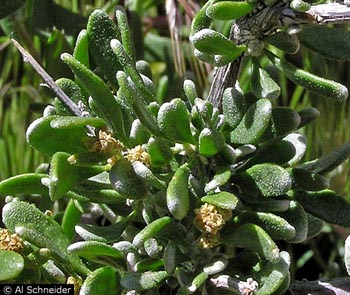Spiny Hopsage

Common Name(s):
Spiny Hopsage
Applebush
Scientific Name:
Grayia spinosa (Hook.) Moq.
Scientific Name Synonyms:
Atriplex grayi Collotzi ex W.A. Weber
Atriplex spinosa (Hook.) Collotzi
Symbol:
GRSPe
Description:
Life Span: Perennial
Origin: Native
Season: Evergreen and deciduous
Growth Characteristics: Spiny hopsage is a long-lived, woody, erect, diffusely branched shrub that reaches 1 to 5 feet in height. Spiny hopsage is evergreen in the southern deserts and deciduous in the summer in the northern deserts. It is generally dioecious, although in some populations monoecious plants are found. Flowers April to July and regenerates both from wind or gravity-dispersed winged seed and vegetatively by sprouting after top-killing disturbances such as fire.
Flowers/Inflorescence: Flowers are clustered, green, and male and female flowers usually occur on seperate plants.
Fruits/Seeds: Fruit is an achene, enclosed in 2 bracts. The bracts are thin, smooth, greenish-white or reddish, and each having a wing on the back or midrib.
Leaves: Alternate, or occasionally occurring in fascicles of two. The blades are spatula shaped and fleshy, with a gray-green surface. Leaves are ½ to 1 ½ inches long.
Stems: Twigs are rigid, erect, and white, becoming reddish-pink with white striations formed by stringy exfoliating bark with maturity. The branches are divergent and spine-like. The trunk bark can be quite variable, ranging from smooth and yellowish-white to red and striate. Usually reddish-gray, exfoliating into thin strips. White striations may persist.
Ecological Adaptions:
Spiny hopsage grows on dry plains, deserts, and foothill slopes at elevations between 2,000 and 5,500 feet. It is highly tolerant of drought and fairly tolerant of grazing and fire.
Soils: It is adapted to alkaline, limestone, gravelly, and dry, heavy, clay soils. It prefers sandy soils that are free of salt and hardpans.
Associated Species: Utah juniper, greasewood, sandberg bluegrass.
Uses and Management:
Spiny hopsage is tolerant of grazing and where abundant is a valuable browse plant for many species of wildlife and livestock. Spiny hopsage provides a palatable and nutritious food source for big game and livestock, particularly during late winter through spring. The fruits are valuable for fattening sheep. The spines may cause minor injury.
Spiny hopsage readily establishes and increases on overgrazed and denuded ranges. It is however, being replaced over wide areas by less palatable species such as green rabbitbrush as a result of heavy pressure by livestock in the spring and early summer. On ranges in good condition, the maximum recommended winter use of annual growth is 80%.
American Indians ground parched seeds to make pinole flour.

